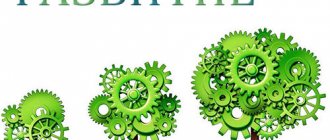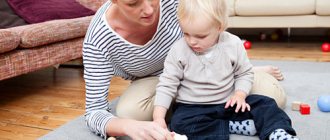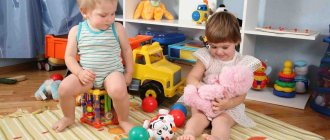Hello, loving mothers and fathers. We are used to raising children in the same way we were raised. Did our parents know what is now available to us? I understood the nuances of the development of small children. What is the upbringing of a 2-3 year old child: psychology, expert advice for your attention. Want to figure it out? Then let's go!
What should a two-year-old child be able to do according to the Munich Diagnostic System?
For parents who want to know the norms of psychomotor development of children under 3 years of age, it is useful to get acquainted with the Munich functional development diagnostic system. It was developed in 1997 and includes practical indicators of child development. According to this diagnosis, by the age of two years the baby should be able to:
- Walk on tiptoes without adult assistance;
- Stand on one leg for a short time;
- Jump;
- Go up and down stairs while holding the railing;
- Open doors;
- Unscrew and tighten the caps;
- String large beads onto a cord;
- Build towers from cubes;
- Throw and roll the ball;
- Name animals;
- Name parts of the body;
- Sort by color, size and shape;
- Correlate the image in the picture with the real object;
- Sing songs;
- Speak in short phrases;
- Play with peers;
A two-year-old child is already quite independent. The baby already has quite well developed coordination, he is constantly in motion. With the help of adults, a two-year-old can easily take care of himself: go to the potty, drink from a cup, eat with a spoon, wash and dry his hands, undress. Support your child's initiative and give him freedom - this way he will quickly learn to be independent.
PSYCHOLOGICAL PORTRAIT DURING SEPARATION
The psychology of 2-3 year old children is characterized by egocentrism. They believe that everything in the world is intended and happens only for them. Everything that diverges from this concept causes screams, protests, outrage, loud crying, and hysterics. Now it is very important to convey to the child a socially reasonable framework for expressing one’s dissatisfaction. “Educational fairy tales” will be a great help with this. If there is no fairy tale for a specific case, you can compose one.
Trying to establish his own independence, the child tries to manipulate his parents: unexpected demands appear to help him do what he can easily do on his own. Here it is important to make it clear to the child that adults are proud of how well he does it without them, and constantly praise him for his independence.
In the children's group, the kids still interact poorly: they do not play together, but side by side. But the need to communicate with peers is high. Therefore, it is important to provoke children to take joint action. At the same time, adults should observe whether their baby is striving to become an authoritarian leader to whom everything around him belongs and obeys. His leadership inclinations need to be directed in the right direction, helping to develop communication skills not through forceful means, but through constructive communication.
Advice
Remember that during this period the baby actively adopts the style of communication and behavior of the adults around him. Avoid aggression, teach him dialogue with others, teach him to follow the rules established in a particular society (routine in kindergarten, behavior in a team).
Development of perception in two-year-old children
If in the process of movement the baby explores the capabilities of his body, then with the help of perception (vision, hearing, smell, touch, taste) the child learns about the world around him.
- Vision . It is through vision that children, like adults, receive most information about the world. Children at the age of 2 already have good visual coordination and are able to follow a moving object with their eyes and distinguish between horizontal and vertical lines. However, they cannot yet simultaneously perceive the whole and the parts, so if the baby is in a crowd, it will be difficult for him to quickly detect his adult.
- Rumor . It is worth paying attention to the child’s auditory perception, since if there are hearing problems, the baby will most likely experience difficulties in speech development. At 2 years old, a child should be able to distinguish intonation well and understand simple requests.
- Taste and smell . For some reason, in our culture, practically no attention is paid to the role of these analyzers in a child’s exploration of the world. At the same time, in France, the development of taste buds is considered an important stage in the psycho-emotional development of a child.
- Touch . Tactile contact with significant adults is very important for the mental and physical health of the baby. It is thanks to him that children develop trust in the world, a sense of security and love. In early childhood, tactile perception of objects is on a par with visual perception. Babies acquire ideas about such concepts as cold/hot, hard/soft, smooth/rough thanks to tactile sensitivity.
For the development of a 2-year-old child, it is very important that the baby receives as many impressions as possible. It is desirable that information be obtained from different sources. In the nursery, for the harmonious development of children, a Montessori environment is organized, from which every child can learn exactly what he needs at the moment.
BRIEFLY ABOUT THE MAIN THINGS
At the turn of 2-3 years, there are two main moments in the development of the baby, which should be given special attention: the beginning of separation and the period of “why”. It is these distinctive features that largely influence the further development of the baby: physical, mental, emotional. How this period will pass will depend on the correct behavior of the parents: in “atomic wars” or “peace and harmony”.
Parents of two-year-old children know firsthand who the “why” is. Thousands of questions from morning to evening during this period are common: the child begins to actively learn about the world around him, its patterns, the interaction of objects, the structure of objects, methods of communication.
But not all parents have heard about separation. However, most of them have probably already encountered the categorical childish statements “I don’t want to, I won’t” and “I myself.” Separation is the process of separation in the minds of the baby between him and his parents. This concerns personal space, desires, demonstration of one’s own achievements, and independence as such. It is now important for the child to prove to the adults in the family that his word or desire has weight, his opinion must be taken into account by elders, and his skills can be proud of.
He begins to realize himself as a person, relates himself to “I”. Therefore, he tries to understand and expand the boundaries of “his territory”, to establish himself. Hence the endless whims, refusals, demands that were not previously observed.
This period is one of the most stressful. But it means that the baby is developing correctly, the next stage has arrived on time. It should end with the affirmation of equality in communication between adults and children.
Personal hygiene skills
A two-year-old child is already quite independent, and many parents strive to instill in their child the skills of self-care and personal hygiene. If you approach this issue wisely, then at 2 years old the child will be able to independently:
- Wash;
- To wash hands;
- Brush your teeth;
- Go potty.
Potty training is a challenge for many. Some try to force a child to sit on the potty, while others do not attach much importance to this skill. Scientists have found that children themselves begin to strive to go to the potty at the age of 1.5 - 2.5 years. Until this time, babies are just learning to control their intestines and bladder. Therefore, under no circumstances should you scold your child for “wet matters.” If the child himself wants to go to the potty, be sure to encourage this, praise any attempt by the child to control his body and be patient. Some people potty train quickly, while others constantly pee in their pants at 2 years old, but this is not a deviation from the norm. Be patient and your baby will definitely learn to go potty.
INTELLIGENCE, LOGIC, MEMORY, THINKING
Now the young researcher is capable of some analysis. For example, he thinks about an action before committing it. Let's say, in order to get a vase of sweets from a high shelf, he will think and bring a chair.
He understands what result this or that action will lead to (if you touch a hot pan, it will hurt, if you throw a ball at the wall, it will bounce, if you stand over the edge of the bed, you will fall). The baby becomes more attentive and observant (this is where most of his “whys” come from).
At this age, it is difficult for a child to maintain attention on one thing for a long time, but he should be able to concentrate on an object or phenomenon of interest for at least 15 minutes.
Memory and logical thinking have already reached a certain level, the child has turned into a researcher and designer. He already knows how to:
- assemble dismountable toys from 4 or more parts (pyramid, puzzles, tower made of cubes);
- determine to which object a separate part of it belongs (hair - to a doll, a wheel - to a typewriter, a wing - to a bird);
- distinguish objects by colors, shapes (circle, square, triangle), properties (heavy, soft, warm);
- find the missing details in the picture (the house has no door, the dog has no tail);
- identify an object by its description;
- describe the plot of the picture;
- tell what you did during the day.
Advice
If a 2.5-year-old child uses monosyllabic sentences to tell stories, provoke him to give detailed answers with leading questions and then ask him to collect all the answers into one complete one. Set an example if your child fails to do it the first time.
Features of different temperaments
Often problems and disobedience arise due to the wrong approach to raising a child. If you do not take into account the individual characteristics of your child, you will very often encounter misunderstandings and hysterics. All people are divided into 4 groups according to the type of temperament, each baby develops it from birth. However, there are no ideal representatives of this or that group. The division occurs according to the principle of the predominance of traits characteristic of one of the temperaments.
- Sanguine people are often called problem-free children. Representatives of this group are characterized by: the absence of loud hysterics with falling on the floor, mobility, high self-esteem, no sleep problems and a strong nervous system. But these are cunning children: parents often take them at their word and follow their lead. They cannot be forced to do what they do not want. The main problem of sanguine people is lying, it needs to be stopped, and the baby’s words must be checked. Also, they should not be praised often or a lot.
- The most difficult people to raise are melancholic people. They are characterized by: vulnerability, difficulties when changing the environment, rapid fatigue, and high sensitivity. Under no circumstances should you shout at them, as this is tantamount to physical violence. Representatives of this type should not be shamed, especially discussing their failures in front of other children.
- Phlegmatic people are the most balanced. They are sleepy, slow and rarely show their emotions. They need to demonstrate everything by example, engage in joint activities with them and try to involve them in active games.
- Cholerics are characterized by restless sleep, short temper, activity, and mobility. They make a lot of noise. The danger is that people of this type often lead an antisocial lifestyle, show aggression towards peers and are domestic tyrants. You cannot punish them physically or ignore them. Promote your life principles.
The main task of parents is to form a character in the child that will smooth out temperamental deficiencies. An individual approach will allow you to do this as efficiently and gently as possible. Try to avoid direct and unfounded prohibitions.
Physical changes
The height development of a two-year-old child begins to slow down and averages about 10 cm per year. Weight increases by 2.5-3 kg.
- The proportions of the body change: the growth of the head stops, but the development and elongation of the lower limbs begins.
- The percentage of adipose tissue decreases, as a result of which the swelling of the cheeks and tummy disappears.
- At two years old, the face loses its roundness, the legs become long and slender.
- The “pads” on the inside of the foot disappear.
- Thanks to the increase in elasticity in the muscles, the child’s body becomes similar to an adult.
INTERESTS, IMAGINATION, CREATIVITY
The young researcher, thinker and designer constantly shows new interests. Everything interests him:
- listen to his mother’s reading (now he understands the essence of what he heard, remembers, analyzes, and can retell the plot in general terms);
- describe what is happening around you during a walk, depicted in pictures, seen in a cartoon;
- figure out what to do (at the same time, the child can synthesize the most incredible experiments - dressing up a cat, painting mom’s pie dough, drawing on shoes, etc.).
- fantasize. This is one of the most striking manifestations of age - the more incredible the child’s fantasies during this period, the more fully his intellect develops. At the same time, there is no need to scold a child for his inventions - on the contrary, a wild imagination is worthy of praise and development by adults.
The age of 2-3 years is the time for the active development of creative abilities. The child becomes extremely interested in expressing himself in a variety of areas, such as designing, drawing, modeling, writing incredible stories, putting together mosaics, etc.
During this period, it is important to provide the child with room for creativity. You can draw with pencils, paints (including finger paints), soap foam, or fingers on flour or sand. Sculpt - from plasticine, clay, dough. Working with sand plays an important role in tactile development. You can collect and build construction sets (Lego), mosaics, puzzles, pyramids, cubes. At the same time, the most incredible designs should be enthusiastically accepted by adults as a manifestation of the maturity of their child. This will give the baby confidence.
Advice
Try to become your child's ally in his creativity, a companion in such games. This will help minimize confrontation, give the baby confidence in your love and pride in him, and allow him to feel protected.
These are the main age characteristics of children 2-3 years old. Yes, it’s not easy with a baby during this period: it’s as if he’s been replaced. But adults must understand the main thing: it’s not easier for the baby. His behavior is not simple whims, but an important segment on the path of development, which his parents should help him get through. The child needs to emerge from this stage with new valuable baggage: acceptance of adults who have equal rights in communication, socialization skills, and many new skills. And most importantly - with the feeling that he is loved not for his actions, but because he exists, with the feeling that he has reliable protection, stability and independence. Whatever concepts he calls it for himself.
Moral education
At the age of 3 years, it is already possible to instill in children a love for their native places and develop citizenship. You should start with the development of self-respect, nobility in relation to others in everyday life, and the study of national culture. If you present it in an interesting way, children will quickly learn everything. The easiest way to instill patriotic education is through animation. There are many cartoons, both modern and Soviet, that convey noble and strong images of knights, Russian heroes, as well as brave women prone to self-sacrifice.
Games
Games occupy one of the first places in education. By the age of two, many children develop skills in handling pencils, plasticine and watercolors.
To speed up the development of fine motor skills in children, you can teach your child to draw with a brush or simply with a finger, dipping it in paint and leaving prints of your small palms on a sheet of Whatman paper attached to the wall of the room.
At two years old, you can play role-playing games with your baby.
In the sandbox, girls and boys of two years old are already capable of not only digging a hole. They will be able to make Easter cakes if they are taught this, or pave the way for a typewriter. At home, you can try playing with a doll - bathing it, feeding it, putting it to bed. Girls especially love these games. During the game, such qualities as love and care are nurtured. Along the way, ordinary everyday items are studied: soap, washcloth, towel.
At the age of two, both boys and girls are already able to independently find a way out of a difficult situation. For example, they like to pull out a rolled ball from under a chair, or play hide and seek. You can try to solve simple riddles together. To interest children in this useful activity and help them with the answer, it is good to make large drawings depicting the object or animal that needs to be guessed and show it in case of difficulty. This is where memory and ingenuity develop.
But when working with a two-year-old child, you should always remember that two-year-old children cannot perform the same actions for a long time. It is difficult for them to sit in one place for more than half an hour, so all activities should be limited in time.
How to educate correctly: advice from a psychologist
Psychology identifies this type of education as extremely important, therefore moral education should begin from the first three years of life. In psychology, the main factor in the development of a child’s morality is the formation of good relationships with other children and adults.
Every child adopts the behavior of adults; accordingly, the main aspect of good upbringing is the correct behavior of the mother and father in the family.
From an early age, you need to begin to instill respect, sociability, friendly treatment of people, develop empathy, the ability to reckon with others, and the need to help others.
Help your baby talk
Some parents become very worried when their two-year-old child stubbornly refuses to speak or gets by with five to ten words. Introduce your son or daughter to new objects and phenomena, naming them several times. Take every opportunity to expand your baby's vocabulary. We must not forget about the development of fine motor skills, which, according to psychologists, is closely related to speech. Therefore, give your child plasticine, a construction set with large parts, and a sorter toy.
Read also: Development of children's speech with the help of Mersibo games










